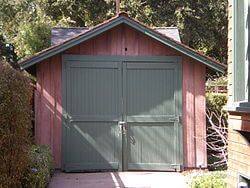Innovation, Garages and Pizza Ovens
May 26, 2012Posted by Forno BravoMention the words garage and innovation, and many people will quickly conjure up visions of Hewlett, Packard, Wozniak, and Jobs. The Silicon Valley success that started in a garage is the stuff of legend—and it’s a well-earned legend. Start-up companies that built their first products in their garage, long before the even had enough money for company offices, have gone on to create some of the world’s most wonderful, and popular products. Today, the HP garage is a designated California historic landmark and is listed on the National Register of Historic Places.
In our own small way, Forno Bravo is part of this heritage. I built the first Primavera prototypes in my garage (I really built them and I really used my garage) at a time when Forno Bravo was exclusively an importer and we were not set up for manufacturing. It was an exciting time, and I was distinctly aware that my plan might succeed and it might fail. Either way, it was thrilling to go out on a limb and try something new. Happily, it all worked out.
But that got me thinking. At the time, I hadn’t really connected the dots, but my grandfather was also a garage entrepreneur. He was born in North Dakota in 1904 to a large farming family, and in 1922 became the only member of his family to attend college—earning an engineering degree from North Dakota State. While working for the FCC in Sunnyvale, CA in the 1950s as a communications engineer, he did his homework and found two spots on the FM radio spectrum that were licensable as radio stations.
To quote Wikipedia:
A broadcast license (U.S.) or broadcast licence (elsewhere) is a specific type of spectrum license that grants the licensee the privilege to use a portion of the radio frequency spectrum in a given geographical area for broadcasting purposes. The licenses are generally straddled with additional restrictions that vary from band to band.[1] In some cases, the FCC does not assign licenses to any exclusive user, but allows qualified users to obtain a license [1] The Radio Act of 1927 established the regulatory premise that persists to this day: the spectrum belongs to the public and that licensees have no property rights to continue using it.[2] Although the spectrum is licensed to bidders, the purchase does not represent ownership or rights, only privileges to using that part of the spectrum.
He received a license for the stronger of the two locations and he built the radio transmitter in his garage. Without any external funding, he launched the radio station in the early 1960s, and by the time I was a small child, he had sold it. He never worked again, retiring in his late 50s. As a child, my main memories of my grandfather were that he liked fishing, Cadillacs, Ham Radio, and the Coleco Adam personal computer. I wonder what would have happened if he had come of age during the Internet era.
Speaking of Silicon Valley, there is one last interesting twist to the story. My grandfather leased a pad from a farmer, who, the story goes, offered to sell him the land. As a childhood memory, I can still picture the transmitter sitting in a huge field of tomatoes. Forget the radio station, five acres in the middle of Silicon Valley is probably worth a fortune today.
So, here’s to garage entrepreneurs in the family.






